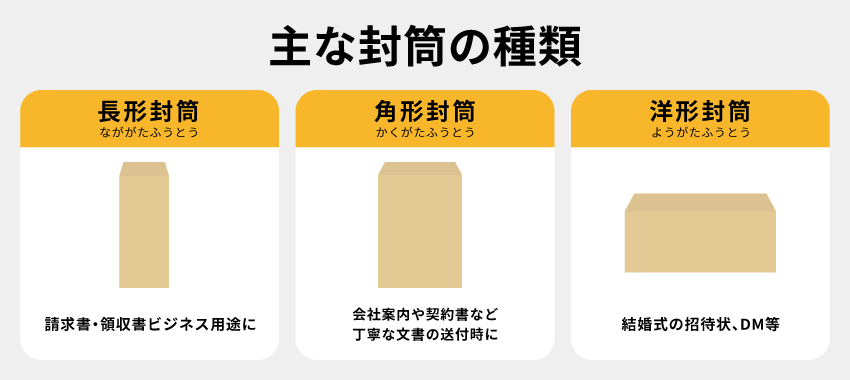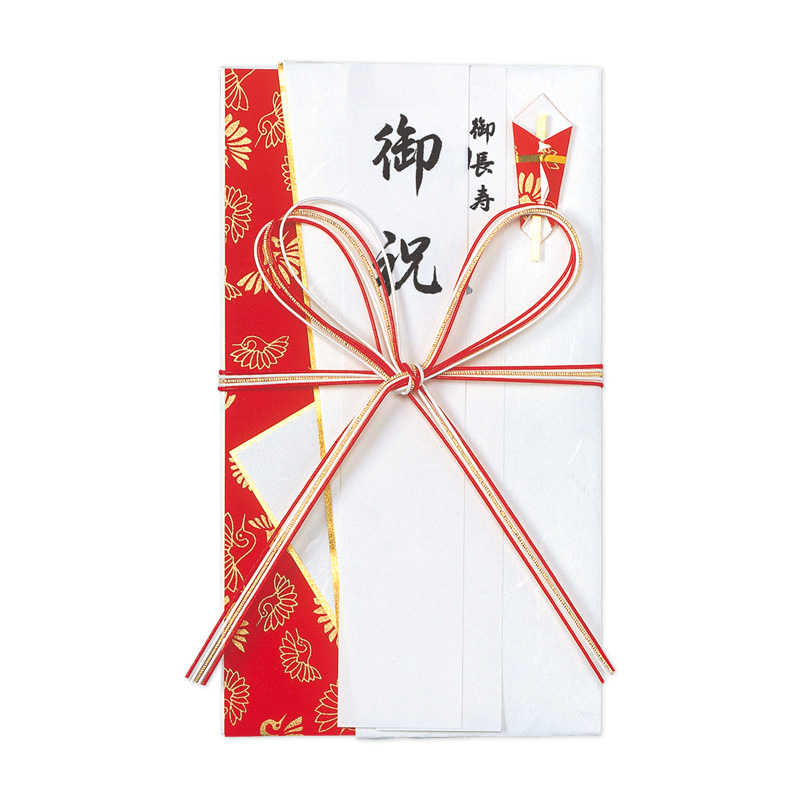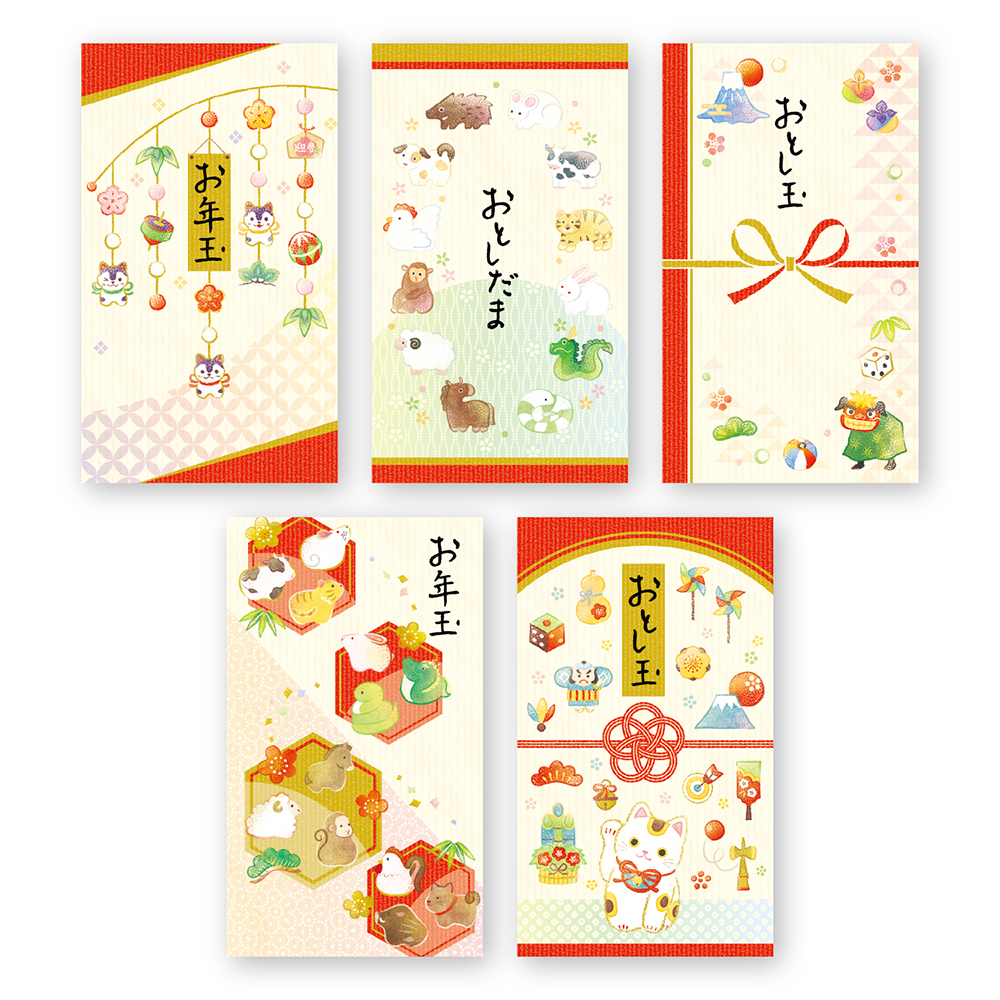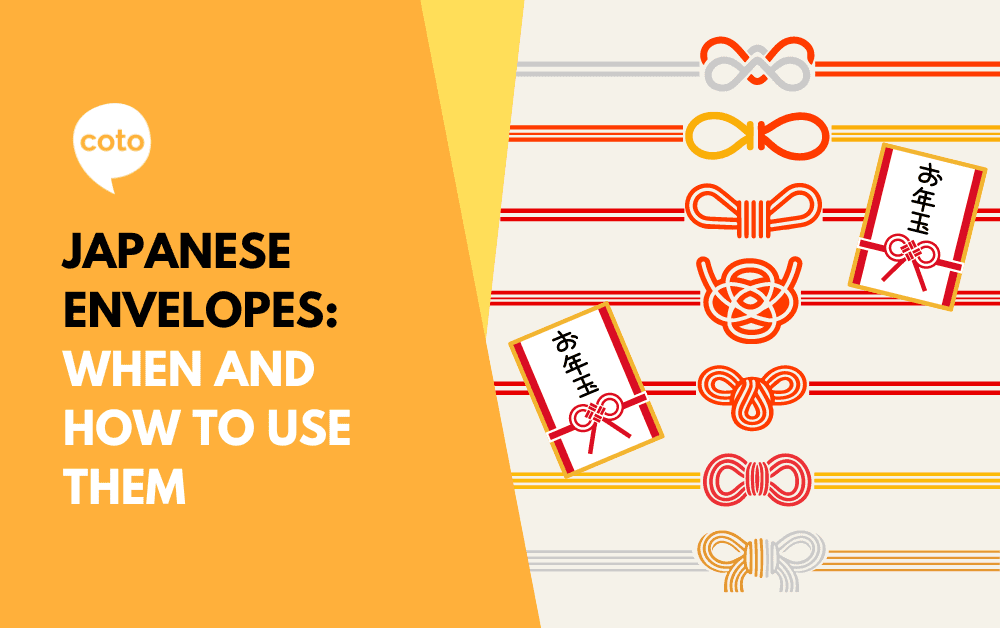Envelopes are more than just paper pockets in Japan. They hold messages, express respect, and even symbolize auspicious occasions. From everyday letters to celebratory gift money, each type serves a specific purpose, adding a layer of cultural nuance to communication. This blog will discuss the diverse world of Japanese envelopes and unveil their proper usage.
A Quick Jump To…
- The Big Three
- Beyond the Ordinary: Special Envelopes
- General Envelope Preparation For Special Envelopes
- Shugi-bukuro Preparation
- Koden-bukuro Preparation
- Pochi-bukuro Preparation
- Things To Be Aware Of
- Etiquette is Key
- FAQ
The Big Three

長形 Choukei
The classic “long shape” with vertical orientation is perfect for handwritten letters, official documents, and invitations. Use white envelopes for formal settings and subtle patterns for casual interactions.
角形 Kakutei
The “square shape” boasts a horizontal orientation, often favored for printed materials like brochures, contracts, or some formal documents.
洋形 Youkei
The “Western-style” envelope mimics standard Western sizes and orientations, ideal for sending photographs or internationally addressed mail, as well as invitations and letters.
Beyond the Ordinary: Special Envelopes
祝儀袋 Shugi-bukuro

Gift money envelopes adorned with decorative cords (水引き Mizuhiki) and auspicious symbols for weddings, graduations, and other celebrations. Choose appropriate colors and designs based on the occasion.
香典袋 Kōden-bukuro

Unlike Shugi-bukuro but with black and white Mizuhiki, condolence envelopes offer condolences and monetary support to bereaved families.
ポチ袋 Pochi-bukuro

Small, colorful envelopes are primarily used to gift children money, often featuring popular characters or festive designs.
General Envelope Preparation For Special Envelopes
Most of the Japanese envelopes come with another envelope inside. Usually, you write down the amount of money you spend in front and your address and name in the back!
The amount should be written in kanji like ‘金〇〇圓,’ but no worries, refer to the table below for the kanji of the number. There is no problem in Arabic as well if you are not Japanese.
| Numbers | Numbers in Kanji |
| 1 | 壱 |
| 2 | 弐 |
| 3 | 参 |
| 5 | 伍 or 五 |
| 7 | 七 |
| 8 | 八 |
| 10 | 拾 |
| Man | 萬 |
| Yen | 圓 or 円 |
Shugi-bukuro Preparation
How much to put in the shugi-bukuro? It varies depending on the relationship you have with the person. However, there is a generic rule for how much you should give. Refer to the table below.
| Friends | 30,000 – 50,000 yen | |
| Work Related | Boss | 30,000 – 50,000 yen |
| Colleague | About 30,000 yen | |
| Junior | 20,000 – 30,000 yen | |
| Client | About 30,000 yen | |
| Relatives | 30,000 – 100,000 yen | |
| Family | 20,000 – 100,000 yen | |
After you have prepared the money and put it in the envelope, remember to fold the under part over the lower part; otherwise, it will bring bad luck.
Koden-bukuro Preparation
For koden-bukuro, there is also a generic rule of how much you should give; refer to the table below.
| Parent | 50,000 – 100,000 yen |
| Sibling | 30,000 – 50,000 yen |
| Grandparent | 10,000 – 50,000 yen |
| Relative | 5,000 – 10,000 yen |
| Friend | 3,000 – 5,000 yen |
| Acquaintance | 3,000 – 5,000 yen |
| Colleague | 3,000 – 5,000 yen |
For koden-bukuro, remember to fold the upper part over the under part after the money is in the envelope, the opposite of shugi-bukuro.
Pochi-bukuro Preparation
There is no specific way of preparing the pochi-bukuro; however, ensure not to put in the amount of money considered “bad luck,” Check below.
Caution! Things To Be Aware Of!
In Japan, there are numbers that should be avoided when preparing for the money.
- 4 and 9 because it means “death” and “suffer,” respectively.
So, numbers 1, 2, 3, 5, 7, 8, and 10 can be used.
Etiquette is Key
- Address placement: For Choukei envelopes, write the recipient’s name on the right and the address vertically below. Kakutei and Youkei, follow Western conventions.
- Mizuhiki: These decorative cords symbolize good luck and fortune. Learn their colors and meanings to choose the right one for the occasion.
- Formality: White envelopes are the default for formal settings, while patterned ones can be used for casual communication. Avoid bright colors in professional contexts.
You Might Be Wondering…
Can I use Western envelopes in Japan?
Yes, but they are primarily seen in non-formal settings. For formal communication, it’s best to stick to Japanese envelope styles.
Where can I buy Japanese envelopes?
Stationery stores, convenience stores, and online retailers offer a wide selection.
Do I need to use specific colors for different occasions?
While not strictly mandatory, colors have traditional meanings. Red and gold denote celebration, while black and white signify condolence.
How do I tie the Mizuhiki?
Different knots represent different occasions. It’s best to follow instructions on the packaging or ask at a stationery store.
Want to learn and study more about the Japanese language and culture?
Book a free level check consultation with us to join!
